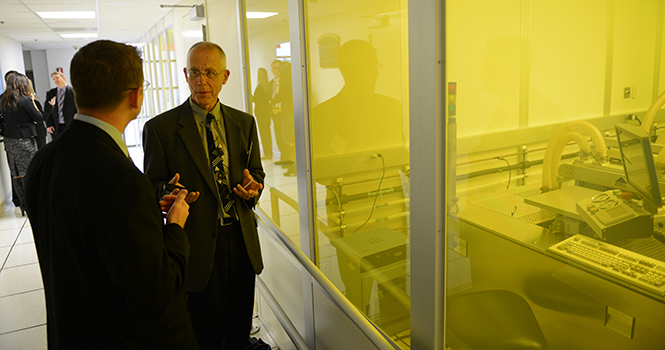Kent State hosts two-day liquid crystal symposium
Timothy Langer from Parker Hannifin Corporation and Joe Klinehammer from GenVac Aerospace talk outside of a class-1000 clean room in the Liquid Crystal Institute building after a tour of the facility on Thursday. The tour of LCI concluded the two day Photo by MATT HAFLEY.
September 27, 2012
Kent State’s Liquid Crystal Institute held a two-day symposium to showcase research and innovations in flexible liquid crystal devices.
The event began Wednesday at 9:30 a.m. and concluded Thursday at noon.
The Liquid Crystal Institute at Kent State is a research facility where companies, partners and faculty experiment with liquid crystal technology for possible sale to consumers.
“OK, we have this technology,” said Michael McCreary, keynote speaker and vice president of research and development for E Ink Corporations. “How can we use it, and what novel things can we do?”
Industry professionals from around the world spoke in the KIVA to show other researchers what advances have been — and could be — made with flexible devices.
The first day of the symposium focused on the technological aspects of flexible devices.
McCreary spoke about the future of flexible display devices — for example, he believes a completely malleable, bendable television is possible.
The resources and the technology are out there; we just need to figure out a way to substitute glass for plastic, McCreary said.
Products like Amazon’s Kindle use electronic ink and flexible display, but developments are being made to make the plastic substrate more malleable so it does not break when bending it.
CEO of AlphaMicron Bahman Taheri, another speaker at the symposium, said he uses liquid crystals to create a unique type of eyewear.
“We’re creating things or technologies where it is actually not on the market,” Teheri said. “So we’re not going after something that is preexisting. We’re going after parts that are not even in the system.”
The researchers developed an e-tint technology for eyewear, which allows it to change from transparent to tinted with the push of a button.
“We were asked by the armed forces to develop a special eyewear which allows them to move in and out of buildings, and their eyewear cannot fit in that kind of sun,” Taheri said. “We are now producing it … He had to because no one else was doing it.”
Liquid crystals are not only being used for electronic technologies, they are also used for medical research. The second day of the symposium focused on medical liquid crystal technology.
Matthew Putman, a new scientist who founded the technology company Nanotronics Imaging, works with synthetic structures for regenerative medicine.
“I’ve only been doing this for the last couple of months,” Putman said. “Just think of me as the rubber guy from Ohio.”
Regenerative medicine has also been around since the 1990s but has really taken off recently, Putman said. Scientists are finding ways to help the body repair itself.
Another speaker, Christopher Malcuit, Kent State bioengineering assistant professor, is focusing his research repairing damaged and aging muscle tissues.
Malcuit uses mice as test subjects to study human muscle regeneration.
“I want to bring us back to reality,” Malcuit said. “Although we can regenerate a pretty sizeable muscle defect in a mouse, we are a long way off from being able to do this in people.”
For the two days, 15 presenters spoke about liquid crystal technology. Symposium Chair John West, trustees research professor, gave a tour of the liquid crystal building following the symposium’s conclusion.
Contact Brittney Trojanowski at [email protected].












